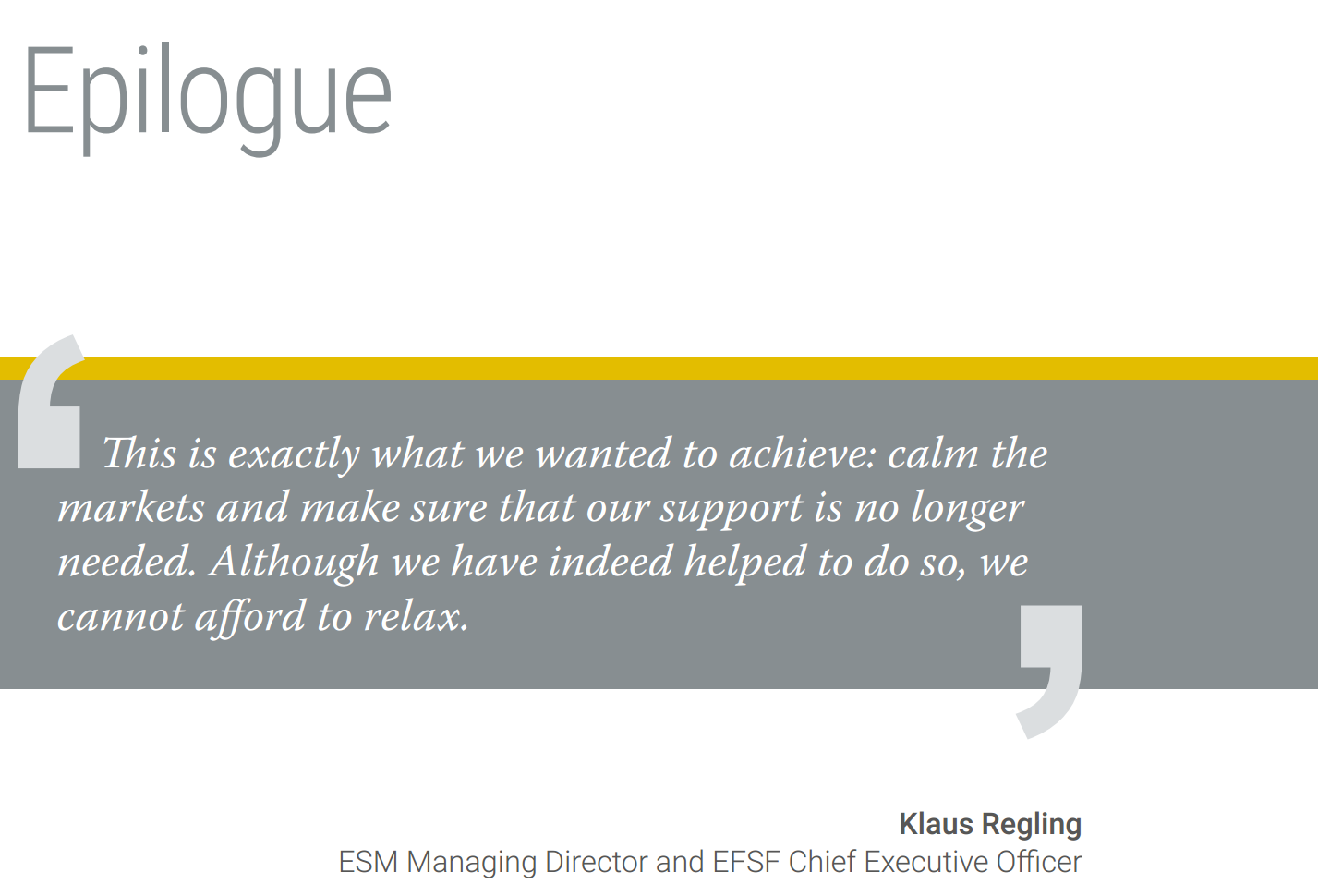Epilogue

The ESM produced this book as part of its mission to protect the euro. It is intended both to commemorate the currency union’s endurance, and to ensure that the lessons of recent history are not forgotten.
Drawing on the experience of the EFSF, the permanent rescue fund was created by Europe’s policymakers in response to the greatest economic shock not only in the life of the euro, but also in the entire post-World War II era of European integration. It was, to be sure, an economic and financial crisis, but also a crisis of the imagination: the euro was set up in 1999 without a rescue fund. The risk that a country that uses the euro could plummet towards default was seen as negligible, or not seen at all.
It thus took time, even in the interdependent euro area economy of the 21st century, for the continent-wide consequences of financial woes in individual countries to sink in. The crisis-response strategy that emerged, gradually, was in keeping with Robert Schuman’s dictum in 1950 that the institutions and governance of a more united Europe would not ‘be made all at once, or according to a single plan.’
In that sense, the rescue fund that exists today was the product of three evolving ‘plans,’ from the bilateral arrangements of the Greek Loan Facility in April 2010, to the EFSF later that summer, and on to the fully fledged ESM in October 2012. For many, especially in countries seeking relief, progress seemed painfully slow. But on the broader timescale of European integration, the record is more impressive. After all, it took a half century, punctuated by a false start in the early 1970s, for European nations to move from the first notions of monetary union to a single currency.
‘Who would have thought, only 10 years ago, that Europe would have put in place a European Stability Mechanism?’ said IMF Fiscal Affairs Director Vítor Gaspar, who served as Portuguese finance minister during the crisis. ‘The progress was quite remarkable. The results were not instantaneous but they could not have been expected to be so.’
Together with fiscal and structural reforms at the European and national level, the ECB’s unconventional monetary policy and the creation of a banking union, the rescue funds saw off the worst of the crisis and made monetary union more resilient.
‘Three things saved the euro zone,’ Greek central banker Yannis Stournaras said. ‘The first was the creation of the EFSF, and later the ESM. The second was [ECB President] Mario Draghi’s decision to do ‘whatever it takes.’ The third, of course, was the governments of the programme countries which took very, very difficult decisions.’
Underlying these three courses of action was a shared approach to economic policy, and a recognition that Europe is better off with a single currency than without one. Rescue fund lending, ECB intervention, and programme country reforms were mutually supportive, and each cannot be conceived of without the others.
The EFSF and ESM were dedicated to safeguarding the stability of the euro area as a whole, by providing financial assistance in return for economic, structural, budgetary and financial sector reforms. Over the course of the crisis, the EFSF’s total financial assistance package reached €185.6 billion, alongside €109.6 billion from the ESM.
As bonds sold to finance this aid come to maturity, the rescue funds will issue new bonds as necessary until all the programme countries have paid back their obligations. In carrying out this day-to-day business of refinancing the loans, the rescue funds are operating in a financial market environment that has been transformed by decisions taken during the crisis. From the EFSF’s first bond sale, the rescue funds have enjoyed a reputation as top-rated borrowers, in turn underpinning sovereign borrowers across post-crisis Europe. The ESM, backed by its Members’ capital and now with an established track record, is at the centre of the architecture sustaining the euro area’s strength.
While it would be best if the ESM’s aid is never again needed on such an extensive scale, the euro area must maintain the capacity to act when required. ‘It’s better to be safe than sorry. It’s an essential element of the euro zone economic governance framework,’ said Rehn, Finnish central bank governor since July 2018, who was European commissioner for economic and monetary affairs and the euro during the crisis.
During 2017 and 2018, the euro area enjoyed strong economic growth. Budget deficits narrowed significantly, and debt fell overall. Growth is benefiting countries across the board, with some of the former programme countries in particular displaying the strongest economic performance thanks to the reforms they undertook. Four of the five countries helped by the EFSF and ESM are economic successes. The fifth programme country, Greece, has also made great strides. It successfully exited its third programme on 20 August 2018 and now needs to continue with its reform agenda to strengthen its growth potential.
The crisis proved the mettle of the ESM as an institution, anchoring it in the euro area landscape. But there was a personal side to this as well. It is impossible to write of the ESM’s contribution to the European project without acknowledging the commitment of its employees, who bring a wide range of professional expertise to the common goal of defending the single currency.
Especially at the start, the hours were long and it was hard to tell whether going to work for a special purpose vehicle in Luxembourg was the right career move. But in the words of Chief Economist Rolf Strauch, echoing the view inside the ESM, the effort was worth it. ‘Personally for me, there is absolutely zero regret. This is probably a once in a lifetime unbelievable roller coaster type of experience,’ Strauch said.
When Schuman proposed pooling French and German coal and steel production as a first step towards European economic unity all those years ago, one of his initial goals was ‘the aim of contributing to raising living standards and to promoting peaceful achievements’[1].
This effort resounds down through the history of what is now the EU, with the ESM standing as the latest example of the practical problem-solving that paves the way for a more prosperous future. As the ESM prepares to take up a new set of challenges envisaged by European leaders, it will strive to do what is right for the citizens of the euro area.
A more robust monetary union contributes to the betterment of all. As ESM Managing Director Regling says: ‘All euro area countries and their citizens benefit.’
Note: The book has annexes with biographies, timeline, EFSF and ESM disbursements, EFSF and ESM rating history, loan re-profiling for Greece, Ireland, and Portugal, acronyms, abbreviations, and country codes, available in the PDF file, see download link below.
Continue reading
[1] Schuman, R. (1950), ‘The Schuman Declaration’, 9 May 1950. https://europa.eu/european-union/about-eu/symbols/europe-day/schuman-declaration_en


